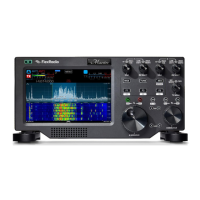FLEX-6000 Signature Series – Maestro User Guide
Copyright 2024 FlexRadio, Inc. All Rights Reserved. | Page 63
13 NOISE MITIGATION
To properly utilize the DSP noise reduction features of the Flex 6000 Series radios, it is important to
understand the type of noise causing interference. There is no single solution for noise mitigation
since different types of noise require different algorithms. Two primary types of noise can be
minimized using DSP techniques: white noise and impulse noise.
White noise is defined as random or uncorrelated noise with a uniform frequency spectrum over a
wide range of frequencies. The sound of rain is an example of white noise. Three techniques are
best used to improve the signal-to-noise ratio in the presence of white noise:
Reduced filter bandwidth
Optimized AGC threshold (AGC-T) setting
DSP Noise Reduction (NR)
Reducing filter bandwidth and optimizing the AGC threshold can significantly improve the SNR
without adding distortion or “coloring” the signal so long as the desired signal is not at the antenna
noise floor. However, DSP noise reduction (NR) can provide significant intelligibility improvement
on weak signals that may be near or below the atmospheric noise floor.
Impulse noise is a category of noise that includes almost instantaneous impulse-like sharp sounds
generated by voltage spikes from arcing power lines, automotive ignition systems, electric fences,
etc. Impulse noise can raise the wideband noise floor received at the antenna by tens of dB and
thus completely mask signals that would otherwise be readable.
Traditionally, “noise blankers” have been utilized to mitigate this type of impulse noise. These
techniques detect the noise pulses and turn off the receiver during the time of the impulse. The
problem with traditional noise blanking techniques is that they have no way to tell strong signals on
the band from impulse noise and can thus “mix” impulses with the strong signals to cause
unwanted interference. The Flex 6000 Series radios incorporate a Wideband Noise Blanking (WNB)
algorithm that can differentiate between modulated signals and impulse noise, virtually eliminating
the “mixing” problem found in traditional blankers. This WNB algorithm operates in real time over
the entire Spectral Capture Unit (SCU) bandwidth to detect and replace impulses with an estimate
of the desired signal.

